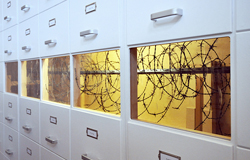ADELAIDE 20 – 30 JULY 2015
Timed to coincide with National Pain Week, The Art of Pain discussed contemporary pain research and its implications. Presented by ANAT, The Bob Hawke Centre Prime Ministerial Centre and Pain Adelaide with the generous support of the Australia Council for the Arts, The Art of Pain comprised of an exhibition, an expert conversation and panel discussions about the experience and management of pain.
 |
Exhibition Keynote Address: 6.00pm – 7.15pm Tuesday 21 July Panel discussions: 5.30pm – 8.00pm Wednesday 22 July |
Exhibition Launch
Monday night featured The Art of Pain exhibition launch. Two artists, Eugenie Lee and Cat Jones, received prestigious Synapse art/science residencies to work with Professor Lorimer Moseley and his research team at Body in Mind. A third artist, George Poonkhin Khut, also worked with pain researchers – in his case, at the Children’s Hospital, Westmead – as part of his Synapse residency in 2011. Each of the three artists has created unique and different responses to our understanding of pain. Cat Jones presented one-on-one performance experiences throughout the 1st week of the exhibition in the Kerry Packer Civic Gallery as part of her installation.
Exhibition Performances – Somatic Drifts
Concept, design and performance Cat Jones, sound design Melissa Hunt.
Somatic Drifts is a sensory, one-to-one artwork and accumulative audio-visual installation.
Somatic Drifts explores trans-human and inter-species empathy. It enables the participant to experience the bodies of other entities, through body illusion and touch. Bodies and narratives travel beyond their own boundaries to ask what realm does the human exist within? How far can we drift? What can this drift enable us to change? More information here.
Somatic Drifts was supported by the Australian government through the Australia Council its arts funding and advisory body; Bundanon Trust AIR; Creative Practice Lab, School of the Arts and Media, UNSW; Adhocracy 2014, Vitalstatistix; and Waverley Studio AIR and SymbioticA. Research for this project was supported by ANAT Synapse Residency with UWA School of Medicine and Pharmacology and UNISA, Sansom Institute, Body in Mind.
Keynote Address
Tuesday night featured Professor Michele Sterling in conversation with Professor Moseley on whiplash and low back pain. Professor Sterling is one of the most important experts internationally on neck pain due to car accidents. She provided an overview of what is what, what is hot and what is not, in the prevention and management of whiplash associated disorders. Her lecture was followed by an interactive session in which she and Professor Moseley discussed some of the more perplexing aspects of neck pain, with questions from the floor.
Panel Discussions
On Wednesday evening there were two panel discussions.
5.30pm-6.30pm: Morphine and mindfulness – same room, different windows?
Morphine-type drugs, called opioids, are commonly prescribed for chronic pain, but they tend to get into the news for the wrong reasons – addiction, tolerance, accidental overdose. Professor Mark Hutchinson is a world authority on the interactions that opioids have with our brain (nervous system) and “other brain” (central immune system). Mark explained how these drugs can be so helpful but also problematic and how the opioids we make in our very own ‘drug cabinet in the brain’ might be similar to, and different from, those we can take in a pill or injection. Dr Tim Semple from the RAH provided a ‘prescriber’s’ perspective. Tim is a Pain Medicine Specialist and Deputy Head of the RAH Pain Unit. Tim discussed the use of opioids and mindfulness from his perspective running a public hospital pain clinic. Another hot topic at the moment is the therapeutic technique of mindfulness – even the TV stars are getting into that. Georgie Davidson is a physiotherapist, yoga teacher and mindfulness practitioner. She blends her diverse and complimentary skill sets to help people in pain. Georgie discussed the use of mindfulness in the real world, both as part of clinical practice and as a way of life. The panel ended with a presentation of an applied mindfulness tool, BrightHearts, developed by The Art of Pain exhibiting artist George Poonkhin Khut and staff specialist, Dr Angie Morrow from the Children’s Hospital Westmead.
From 7.00pm-8.00pm: Playing tricks with the mind – Illusion and its affect.
Research fellow Valeria Bellan discussed how the processing of tactile and painful stimuli informs multisensory integration and body representation – and in particular how our understanding of our peripersonal space informs our experience of pain. Valeria was joined by two of The Art of Pain exhibiting artists, Cat Jones and Eugenie Lee, who have both worked alongside Valeria and other researchers at Body in Mind to test how artistic tools and processes concerned with illusion can contribute to this research.
Image: Eugenie Lee McGill Pain Questionnaire (detail) 2012




